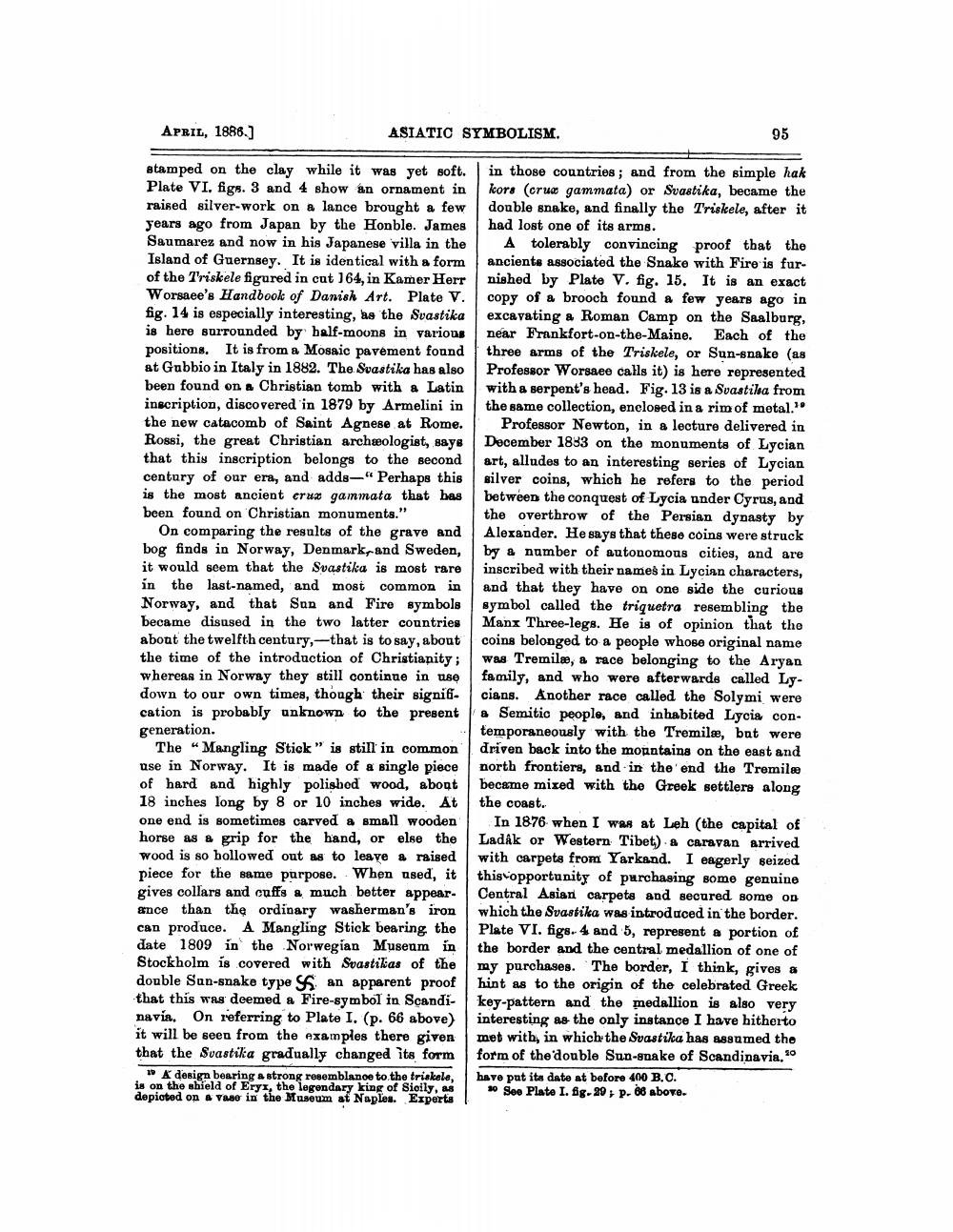________________
APRIL, 1886.)
ASIATIC SYMBOLISM.
95
stamped on the clay while it was yet soft. in those countries; and from the simple hak Plate VI, figs. 3 and 4 show an ornament in kors (cru gammata) or Svastika, became the raised silver-work on a lance brought a few double snake, and finally the Triskele, after it years ago from Japan by the Honble. James had lost one of its arms. Saumarez and now in his Japanese villa in the A tolerably convincing proof that the Island of Guernsey. It is identical with a form ancients associated the Snake with Fire is furof the Triskele figured in cut 164, in Kamer Herr nished by Plate V. fig. 15. It is an exact Worsaee's Handbook of Danish Art. Plate V. copy of a brooch found a few years ago in fig. 14 is especially interesting, as the Svastika excavating a Roman Camp on the Saalburg, is here surrounded by balf-moons in various near Frankfort-on-the-Maine. Each of the positions. It is from a Mosaic pavement found three arms of the Triskele, or Sun-snake (as at Gubbio in Italy in 1882. The Svastika has also Professor Worsaee calls it) is here represented been found on a Christian tomb with a Latin with a serpent's head. Fig. 13 is a Svastila from inscription, discovered in 1879 by Armelini in the same collection, enclosed in a rim of metal." the new catacomb of Saint Agnese at Rome. | Professor Newton, in a lecture delivered in Rossi, the great Christian archæologist, says December 1833 on the monuments of Lycian that this inscription belongs to the second art, alludes to an interesting series of Lycian century of our era, and adds-"Perhaps this silver coins, which he refers to the period is the most ancient crux gammata that has between the conquest of Lycia under Cyrus, and been found on Christian monuments."
the overthrow of the Persian dynasty by On comparing the results of the grave and Alexander. He says that these coins were struck bog finds in Norway, Denmark, and Sweden, by & number of autonomous cities, and are it would seem that the Svastika is most rare inscribed with their names in Lycian characters, in the last-named, and most common in and that they have on one side the curious Norway, and that Sun and Firo symbols symbol called the triquetra resembling the became disused in the two latter countries Manx Three-legs. He is of opinion that the about the twelfth century,--that is to say, about coins belonged to a people whose original name the time of the introduction of Christianity; was Tremilæ, & race belonging to the Aryan whereas in Norway they still continue in use family, and who were afterwards called Lydown to our own times, though their signit- cians. Another race called the Solymi were cation is probably unknown to the present & Semitic people, and inhabited Lycia congeneration.
temporaneously with the Tremilæ, but were The Mangling Stick" is still in common driven back into the moontains on the east and use in Norway. It is made of a single piece north frontiers, and in the end the Tremile of hard and highly polished wood, about became mixed with the Greek settlers along 18 inches long by 8 or 10 inches wide. At the coast. one end is sometimes carved a small wooden In 1876 when I was at Leh (the capital of horse as & grip for the hand, or else the Ladêk or Western Tibet) a caravan arrived wood is so bollowed out as to leave a raised with carpets from Yarkand. I eagerly seized piece for the same purpose. When used, it this opportunity of purchasing some genuine gives collars and cuffs a much better appear. Central Asian carpets and secured some on ance than the ordinary washerman's iron which the Svastika was introduced in the border. can produce. A Mangling Stick bearing the Plate VI. figs. 4 and 5, represent a portion of date 1809 in the Norwegian Museum in the border and the central medallion of one of Stockholm is covered with Svastikas of the my purchases. The border, I think, gives a double San-snake type SS. an apparent proof hint as to the origin of the celebrated Greek that this was deemed a Fire-symbol in Scandi- key-pattern and the medallion is also very navia. On referring to Plate I. (p. 66 above) | interesting as the only instance I have hitherto it will be seen from the examples there given met with, in which the Svastika has assumed the that the Svastika gradually changed its form form of the double Sun-snake of Scandinavia.
* K design bearing a strong resemblance to the triskele, have put ita date at before 400 B.C. is on the shield of Eryı, the legendary king of Sicily, * See Plate I. fig. 20 P. 88 above. depicted on & vase in the Museum at Naples. Experts




